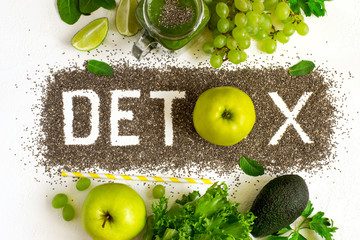1) Giving organs a rest with modified fasting 2) Getting the liver to push toxins from the body 3) Raising elimination through the bowels, kidneys, and skin 4) Improving the circulation of the blood 5) Refueling the body with sound nutrients
Eliminate foods that cause toxicity in the first place. Some doctors suggest a specific, planned detox at least once a year. Some toxins are released through perspiration. If you have access to a sauna, use it to flush toxins out of the body. During a detox, eliminate alcohol, coffee, tobacco, sugars and concentrated fats which act as toxins in the system. Increase the amount of water that you drink to help flush the toxins. You aren’t doing a complete food-fast. You are only fasting from foods that harm you. Minimize the use of chemical-based house cleaners and personal healthcare products and replace with organic alternatives. This is wise with or without a detox. Most antiperspirants, for example, add aluminum, which is toxic. Products that add fragrance are adding toxins into your body. The term “fragrance” includes about a thousand different chemical product options. You won’t know which ones since government regulations only require the product label to list the word “fragrance.” Length of detoxing varies but is usually 3-5 days. If you have diabetes to consider, you might think in terms of 2-3 days, or whatever your doctor deems safe. Check with your medical professional for what you specifically can do. You still need to consume the proper nutrients to keep your blood sugar in the proper range. If you’re up for it and your doctor agrees, try veggie smoothies so you maintain a liquid type diet for a couple of days. This lets your systems rest, but you still get the nutrients you need. You should feel so much better with the liquid version or small intentional meals. Your numbers might dip into the lower range because your body doesn’t need as much of the medications you are taking. Again, be sure you are working with your doctor and not self-diagnosing when it comes to your meds. Continue to eat clean and healthy after a detox, which should keep your glucose levels in a proper range. If they dip lower, it could indicate you don’t need as much medication. Your doctor may even start weaning you off the meds. There are safe detox plans such as veggie juices and some clear fruit juices, like apple and cranberry juice. Be cautious with fruit juices as they are much higher in sugar than vegetables, but they do let your digestive system rest. Avoid orange juice during a detox or fast, since it is so high in sugar. If you purchase detox drinks, make sure they’re organic, cold pressed and not from concentrate. After a detox program, you should be able to keep your body toxin free through diet, supplements and lifestyle changes which help you reach an ideal weight and reboot your health. I believe the importance of a detox is in what you don’t eat: no sugar, flour, rice, potatoes, and none of the carbs that you’re detoxing. If you suspect allergies, then you’ll want to eliminate those possible offenders as well. Once detoxed, you can start adding some eliminated foods back into your diet, but not all at once. If something eliminated is a toxic food for you, you want to know what it is without masking it with everything else. I hope you’ll give it a try! Be sure to read my next post on How and Why to Do a Mental Detox.Marian Hays writes, coaches, and speaks about health and personal growth for people who want to take control of their health and empower their lifestyle. She’s an advocate for others as she researches and shares the truth instead of hype, infused with humor. Her goal is to inspire others to accomplish their goals and work through challenges that might otherwise hold them back. You can find her books on Amazon.
